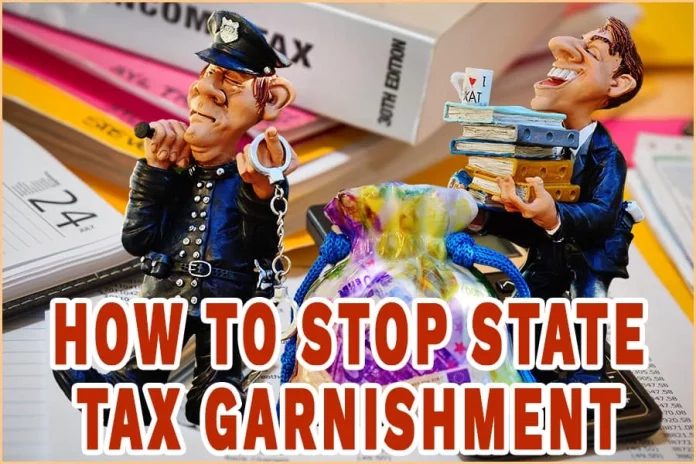Tax garnishment involves the IRS sending legal injunctions to an employer to seize a portion of their employee’s wage to appease a tax debt. This way, they can recover the said debt automatically.
The employer will be obligated to deduct a percentage of your wage every payday to cover the debt plus the accrued interest and delay penalties.
The wage garnishment percentage depends on the existing state laws. Some states deduct up to 25% of your wage while others go up to 50%.
Such deductions can negatively affect other aspects of life, such as covering other bills. The best way to avoid reducing tax punishment is to deal with it as soon as it comes up. Here are ways to stop wage garnishment before and after it is implemented.
How To Stop State Tax Garnishment
The most effective way to stop state tax garnishment is to pay off the debt as soon as you revive the wage garnishment notification. The Internal Revenue Service usually takes up to six months after notifying you before enforcing the garnishment.
Another effective way is to visit the Internal Revenue Service office and work toward a debt payment plan. Ensure that you can fulfill the agreement because defaulting may lead to more financial repercussions.
Other Ways To Stop State Tax Garnishment
Paying the amount in full and agreeing on a payment plan is the most convenient and practical approach to halt tax garnishment. However, other avenues can also work depending on your financial situation. They are as follows.
Request an Offer in Compromise (OIC)
The OIC is a tax-related agreement between the IRS and a taxpayer. It states that you can play the debt less to its actual amount.
If you can convince the IRS that you cannot pay the total amount and agree on an alternative figure, it is an OIC.
However, this is not an easy path to take. Convincing tax officers to waive some debt will be tough to climb.
More than 60% of such offers are usually rejected. You have a better chance at installment payment than OIC.
Nonetheless, you have to fill out a form pay an application fee plus a downpayment of 20%. For instance, if you had a debt of $20K and agreed to pay $16K, you have to pay a deposit of $3200 and submit it with the form.
Appeal the Tax Garnishment
Another option of stopping tax garnishment is appealing the garnishment as soon as you receive the notification.
The notification must have contact details that you can use to contact the office. Call them and launch an appeal if you have substantial ground to do so.
Most appeals are successful if you are tax compliant or have paid the debt in full. You can also appeal if you had successfully filed for bankruptcy, the debt has passed its statute of limitation, or there was an error in your tax history appraisal.
Declaration Of Hardship
In cases where you cannot pay the debt while meeting your daily needs, you can declare hardship.
That will temporarily stop the garnishment order while you find a permanent solution to finishing the existing tax debt.
Anyone who files a declaration of hardship will have to provide sufficient evidence to prove that is their current financial state.
The Internal Revenue Service has to be satisfied that you cannot meet your necessary needs if the garnishment is enforced.
Note that this does not absolve you from the debt. It simply postpones the collection date. It will also have borrowing implications on your credit.
Take the route knowing all the repercussions. The Internal Revenue Service will work with you to develop a convenient plan.
File For Bankruptcy
That is the final option if you want to stop tax garnishment. That is a case where the debt may be curtailed, reviewed, or forgiven, depending on your situation. The court will determine whether the bankruptcy will be accepted or not.
Bankruptcy laws in the United States are broad. Chapter 7 of the US Code (Title 11) involves the liquidation process under bankruptcy laws. On the other hand, Chapters 11 and 13 govern the process of debtor reorganization. The most common bankruptcy filed in the country is Chapter 7.
Many people find Chapter 7 the best option to breathe from debt. If you own little property, this bankruptcy works well for you. This law will wipe out your medical bills, personal loans, and credit card balances. Moreover, it will also stop wage garnishment because the automatic stay order of this law prohibits creditors from collection attempts during the bankruptcy case. But determining if you’re eligible for Chapter 7 bankruptcy law involves a strict process.
The Chapter 7 Means Test can help determine if you don’t have the financial capability to pay off your debt using a specific formula. It’s a multi-step process that compares your household income to your state’s average family income. Hence, the means test prevents individuals with a sufficient monthly household income from not settling their debt. If you’re found to have an adequate household income, you can file for Chapter 13 bankruptcy to pay more of what you owe.
Bankruptcy may be a suitable option for those who do not have another option. However, there are consequences to your credit history.
It will be challenging to access loans and other credit services with bankruptcy appearing on your record.
Reach out to the IRS when you file for bankruptcy. A corporation with the agency makes the whole process easier and smooth. You need to follow guidelines that the IRS will propose and help you through if necessary.
Seek Professional Advice
Another option to stop wage garnishment is seeking a professional tax accountant. They are adept in tax laws and will be able to provide you with the best way forward.
Remember that different states have different tax laws that you might miss. A tax accountant will not miss such details.
Most accountants will offer the consultation services pro-bono. They will evaluate your financial situation versus debt and develop appropriate measures for the list above. The overall services might cost you money, but it is worth it.
One of the benefits of using professional services includes saving time and effort. The accountant will directly deal with the Internal Revenue Service, saving you from the hustle.
What Causes State Tax Garnishing
The main reason for garnishments is to recover tax debts for the federal government. The Internal Revenue Service acts directly and in the federal government’s authority. Any garnishing action that is taken does not require the input of the judicial system.
It is a process of charging accounts or wages to recover money for the government as a tax debt. However, the process is not automatic and without consideration. The Internal Revenue Service will allow you to respond and ultimately find an amicable solution.
Yet if you do not take any steps to clear the debt or respond to the notification, the agency can proceed in tax garnishment. IRS will take use tax garnishing if:
- There is an outstanding tax charge in your name
- You have revived three different notifications on the matter, and there is no response. They include a reminder and charge of overdue tax payment, an intention for tax garnishing, and a notification of your rights concerning tax garnishing.
The IRS will take up to six months to implement the order. It is advisable to pay the tax debt as soon as you receive the notification.
Otherwise, ball or visit the individual retirement account offices to develop a better payment plan.
Remember that overdue taxes attract interest and penalty fees which accrue the longer you wait.
How Long Do Tax Garnishes Last?
Garnishment of taxes will continue unabated for as long as the obligation is owed. That depends on the size of the debt, and it might take months or even years to pay it off.
The only stipulations that can keep the IRS from garnishing are statutes of limitation, bankruptcy, and appeals made within 30 days of notification against planned tax garnishing.
It is not just your wages that they can garnish. They can levy assets and accounts to cover tax debts.
Whether they cover the debts or not, it does not matter. It is an asset that can go a long way in covering the unserviced debt.
If they don’t cover the whole deficit, a lien may be attributed to your income tax refund account.
Can You Stop A Continuing Garnish?
Yes, you can stop a tax garnishment that has already been enforced. However, you need to understand that you must meet tax obligations. The longer you prolong the inevitable, the more you will pay interest and penalty fees.
Nonetheless, if you cannot meet these obligations or the garnishing is applied by multiple creditors, you can negotiate the terms with the IRS. You can stop the process for a period, but you must meet the obligation.
Do All US States Enforce Tax Garnishing?
The federal law has laws that you can use to implement garnishing. However, the implementation depends on the state. Some have modified the laws, while others do not implement them.
Still, more states apply garnishment than those that don’t. There are only four states that do not allow garnishing in the US.
Pennsylvania, Texas, North and South Carolina. However, they exempt tax, child support, student loans, and fines.
In essence, no state is free from garnishing—especially tax-related obligations.
Conclusion
Tax obligation is not limited to the US alone. Taxes build the nation as well as run federal institutions and services. However, you cannot avoid the tax debt in some quarters. That makes tax garnishing a necessary federal process. It helps collect the debt for the government.
Fortunately, you can take some steps to protect the taxpayer—the steps listed above work most of the time. The federal government is not keen on garnishing wages unless it is essential. Try to solve the situation as soon as you can.
Consult a professional tax expert if you have no idea where to start.












![What is the G7? [Member Nations, Objectives, and Summits] G7 summit](https://www.moneytaskforce.com/wp-content/uploads/2019/08/G7-Conference-100x70.jpg)